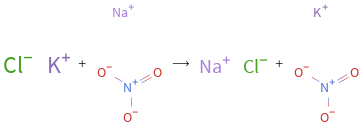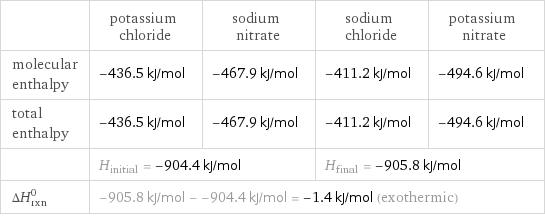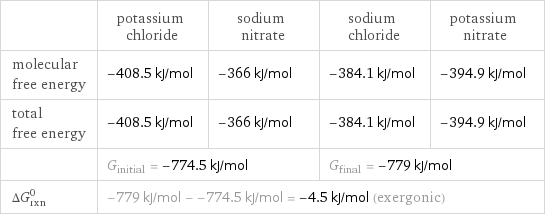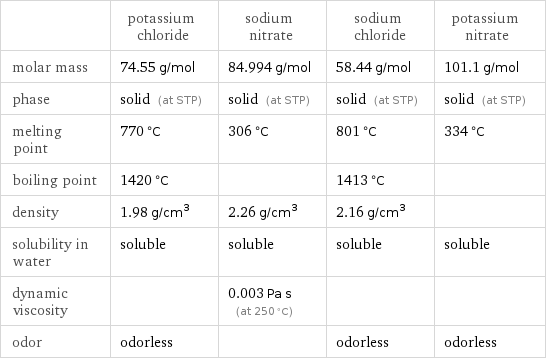Input interpretation

KCl (potassium chloride) + NaNO_3 (sodium nitrate) ⟶ NaCl (sodium chloride) + KNO_3 (potassium nitrate)
Balanced equation

Balance the chemical equation algebraically: KCl + NaNO_3 ⟶ NaCl + KNO_3 Add stoichiometric coefficients, c_i, to the reactants and products: c_1 KCl + c_2 NaNO_3 ⟶ c_3 NaCl + c_4 KNO_3 Set the number of atoms in the reactants equal to the number of atoms in the products for Cl, K, N, Na and O: Cl: | c_1 = c_3 K: | c_1 = c_4 N: | c_2 = c_4 Na: | c_2 = c_3 O: | 3 c_2 = 3 c_4 Since the coefficients are relative quantities and underdetermined, choose a coefficient to set arbitrarily. To keep the coefficients small, the arbitrary value is ordinarily one. For instance, set c_1 = 1 and solve the system of equations for the remaining coefficients: c_1 = 1 c_2 = 1 c_3 = 1 c_4 = 1 Substitute the coefficients into the chemical reaction to obtain the balanced equation: Answer: | | KCl + NaNO_3 ⟶ NaCl + KNO_3
Structures

+ ⟶ +
Names

potassium chloride + sodium nitrate ⟶ sodium chloride + potassium nitrate
Reaction thermodynamics
Enthalpy

| potassium chloride | sodium nitrate | sodium chloride | potassium nitrate molecular enthalpy | -436.5 kJ/mol | -467.9 kJ/mol | -411.2 kJ/mol | -494.6 kJ/mol total enthalpy | -436.5 kJ/mol | -467.9 kJ/mol | -411.2 kJ/mol | -494.6 kJ/mol | H_initial = -904.4 kJ/mol | | H_final = -905.8 kJ/mol | ΔH_rxn^0 | -905.8 kJ/mol - -904.4 kJ/mol = -1.4 kJ/mol (exothermic) | | |
Gibbs free energy

| potassium chloride | sodium nitrate | sodium chloride | potassium nitrate molecular free energy | -408.5 kJ/mol | -366 kJ/mol | -384.1 kJ/mol | -394.9 kJ/mol total free energy | -408.5 kJ/mol | -366 kJ/mol | -384.1 kJ/mol | -394.9 kJ/mol | G_initial = -774.5 kJ/mol | | G_final = -779 kJ/mol | ΔG_rxn^0 | -779 kJ/mol - -774.5 kJ/mol = -4.5 kJ/mol (exergonic) | | |
Equilibrium constant
![Construct the equilibrium constant, K, expression for: KCl + NaNO_3 ⟶ NaCl + KNO_3 Plan: • Balance the chemical equation. • Determine the stoichiometric numbers. • Assemble the activity expression for each chemical species. • Use the activity expressions to build the equilibrium constant expression. Write the balanced chemical equation: KCl + NaNO_3 ⟶ NaCl + KNO_3 Assign stoichiometric numbers, ν_i, using the stoichiometric coefficients, c_i, from the balanced chemical equation in the following manner: ν_i = -c_i for reactants and ν_i = c_i for products: chemical species | c_i | ν_i KCl | 1 | -1 NaNO_3 | 1 | -1 NaCl | 1 | 1 KNO_3 | 1 | 1 Assemble the activity expressions accounting for the state of matter and ν_i: chemical species | c_i | ν_i | activity expression KCl | 1 | -1 | ([KCl])^(-1) NaNO_3 | 1 | -1 | ([NaNO3])^(-1) NaCl | 1 | 1 | [NaCl] KNO_3 | 1 | 1 | [KNO3] The equilibrium constant symbol in the concentration basis is: K_c Mulitply the activity expressions to arrive at the K_c expression: Answer: | | K_c = ([KCl])^(-1) ([NaNO3])^(-1) [NaCl] [KNO3] = ([NaCl] [KNO3])/([KCl] [NaNO3])](../image_source/6dc68ef601bc9e7d63eece5a138deb35.png)
Construct the equilibrium constant, K, expression for: KCl + NaNO_3 ⟶ NaCl + KNO_3 Plan: • Balance the chemical equation. • Determine the stoichiometric numbers. • Assemble the activity expression for each chemical species. • Use the activity expressions to build the equilibrium constant expression. Write the balanced chemical equation: KCl + NaNO_3 ⟶ NaCl + KNO_3 Assign stoichiometric numbers, ν_i, using the stoichiometric coefficients, c_i, from the balanced chemical equation in the following manner: ν_i = -c_i for reactants and ν_i = c_i for products: chemical species | c_i | ν_i KCl | 1 | -1 NaNO_3 | 1 | -1 NaCl | 1 | 1 KNO_3 | 1 | 1 Assemble the activity expressions accounting for the state of matter and ν_i: chemical species | c_i | ν_i | activity expression KCl | 1 | -1 | ([KCl])^(-1) NaNO_3 | 1 | -1 | ([NaNO3])^(-1) NaCl | 1 | 1 | [NaCl] KNO_3 | 1 | 1 | [KNO3] The equilibrium constant symbol in the concentration basis is: K_c Mulitply the activity expressions to arrive at the K_c expression: Answer: | | K_c = ([KCl])^(-1) ([NaNO3])^(-1) [NaCl] [KNO3] = ([NaCl] [KNO3])/([KCl] [NaNO3])
Rate of reaction
![Construct the rate of reaction expression for: KCl + NaNO_3 ⟶ NaCl + KNO_3 Plan: • Balance the chemical equation. • Determine the stoichiometric numbers. • Assemble the rate term for each chemical species. • Write the rate of reaction expression. Write the balanced chemical equation: KCl + NaNO_3 ⟶ NaCl + KNO_3 Assign stoichiometric numbers, ν_i, using the stoichiometric coefficients, c_i, from the balanced chemical equation in the following manner: ν_i = -c_i for reactants and ν_i = c_i for products: chemical species | c_i | ν_i KCl | 1 | -1 NaNO_3 | 1 | -1 NaCl | 1 | 1 KNO_3 | 1 | 1 The rate term for each chemical species, B_i, is 1/ν_i(Δ[B_i])/(Δt) where [B_i] is the amount concentration and t is time: chemical species | c_i | ν_i | rate term KCl | 1 | -1 | -(Δ[KCl])/(Δt) NaNO_3 | 1 | -1 | -(Δ[NaNO3])/(Δt) NaCl | 1 | 1 | (Δ[NaCl])/(Δt) KNO_3 | 1 | 1 | (Δ[KNO3])/(Δt) (for infinitesimal rate of change, replace Δ with d) Set the rate terms equal to each other to arrive at the rate expression: Answer: | | rate = -(Δ[KCl])/(Δt) = -(Δ[NaNO3])/(Δt) = (Δ[NaCl])/(Δt) = (Δ[KNO3])/(Δt) (assuming constant volume and no accumulation of intermediates or side products)](../image_source/263740b36994a5ce21ca0050cfca9d00.png)
Construct the rate of reaction expression for: KCl + NaNO_3 ⟶ NaCl + KNO_3 Plan: • Balance the chemical equation. • Determine the stoichiometric numbers. • Assemble the rate term for each chemical species. • Write the rate of reaction expression. Write the balanced chemical equation: KCl + NaNO_3 ⟶ NaCl + KNO_3 Assign stoichiometric numbers, ν_i, using the stoichiometric coefficients, c_i, from the balanced chemical equation in the following manner: ν_i = -c_i for reactants and ν_i = c_i for products: chemical species | c_i | ν_i KCl | 1 | -1 NaNO_3 | 1 | -1 NaCl | 1 | 1 KNO_3 | 1 | 1 The rate term for each chemical species, B_i, is 1/ν_i(Δ[B_i])/(Δt) where [B_i] is the amount concentration and t is time: chemical species | c_i | ν_i | rate term KCl | 1 | -1 | -(Δ[KCl])/(Δt) NaNO_3 | 1 | -1 | -(Δ[NaNO3])/(Δt) NaCl | 1 | 1 | (Δ[NaCl])/(Δt) KNO_3 | 1 | 1 | (Δ[KNO3])/(Δt) (for infinitesimal rate of change, replace Δ with d) Set the rate terms equal to each other to arrive at the rate expression: Answer: | | rate = -(Δ[KCl])/(Δt) = -(Δ[NaNO3])/(Δt) = (Δ[NaCl])/(Δt) = (Δ[KNO3])/(Δt) (assuming constant volume and no accumulation of intermediates or side products)
Chemical names and formulas

| potassium chloride | sodium nitrate | sodium chloride | potassium nitrate formula | KCl | NaNO_3 | NaCl | KNO_3 Hill formula | ClK | NNaO_3 | ClNa | KNO_3 name | potassium chloride | sodium nitrate | sodium chloride | potassium nitrate
Substance properties

| potassium chloride | sodium nitrate | sodium chloride | potassium nitrate molar mass | 74.55 g/mol | 84.994 g/mol | 58.44 g/mol | 101.1 g/mol phase | solid (at STP) | solid (at STP) | solid (at STP) | solid (at STP) melting point | 770 °C | 306 °C | 801 °C | 334 °C boiling point | 1420 °C | | 1413 °C | density | 1.98 g/cm^3 | 2.26 g/cm^3 | 2.16 g/cm^3 | solubility in water | soluble | soluble | soluble | soluble dynamic viscosity | | 0.003 Pa s (at 250 °C) | | odor | odorless | | odorless | odorless
Units
